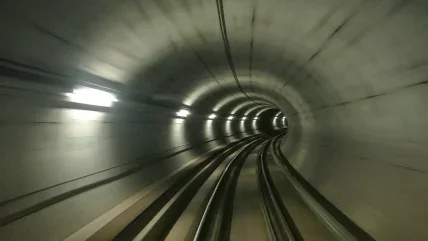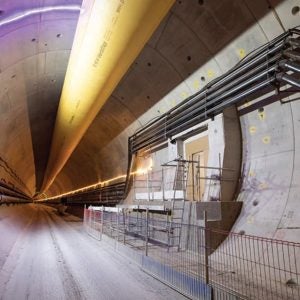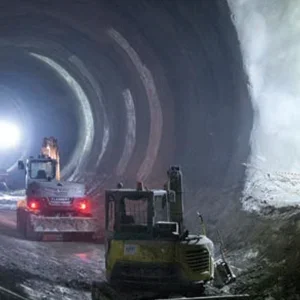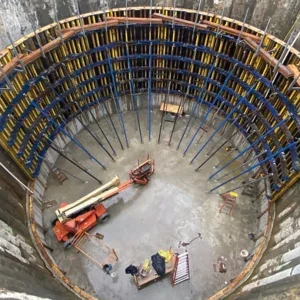
Intended to describe what is judged to be best practice or guidance, the 3rd edition of the Code of Practice for Risk Management in Tunnel Works was jointly published earlier this year by the International Tunnelling and Underground Space Association (ITA) and the insurance industry, represented in the International Association of Engineering Insurers (IMIA).
As they say in the Preface to the 28-page report, the Code is not legal or a legally binding document in itself – but, they add, “It may, however, be contractually binding if referred to as such in, for example a construction contract or an insurance policy.”
The intent of the Code is strategic with advisory tactics. It was prepared jointly by the insurance and tunnelling industries to help reduce the frequency and severity of serious incidents, that result in insurance claims, “to within sustainable boundaries.” The organisations add that if the best practice is followed in management of construction risks then not only should the significant insured losses be reduced but so, too, should uninsured losses be lessened across the industry.
To get there, the organisations surveyed for opinions on how the prior edition of the Code had been applied, and key areas of revision in the update, which the chapter structure follows, include primarily: listing principal attributes expected in the Code; considering competence and culture; differentiating between what is risk management and what is the management of risk; and, clarifying the importance of managing high consequence events.
Language improvements have been pursued in emergency response plans, and also for activities in instrumentation and monitoring.
The Code has been used for 20 years and, in the new era of digital work in construction, the updated includes a section of digital modelling.
Widespread adoption of the Code, built upon the first two editions, “has succeeded in reducing incidents and losses to tolerable levels,” the authors say.
They add that, for the tunnelling industry, the Code “represents a robust framework on which projects can be modelled” while the insurance industry “uses the Code as a benchmark against which projects can be assessed” – and compliance may be needed to get cover during the construction phase, focused on Construction All Risks insurance.
For tunnel projects, the guidance is intended to sit alongside local laws, regulations and standards – but, on the latter, will lead where its provisions “are more extensive and/or more onerous”.
The Code’s 3rd edition has 11 chapters (all are succinct with discussion of the ‘Construction Stage’ the longest), two appendices (definitions & terms; and, a clause-based schedule of deliverables), and its format is solely text and tables.
Objectives & Scope
In outlining the objectives of the Code, the guide states it covers both design and construction of tunnel projects, that it requires risks to be identified, allocated and managed (using assessments, registers and treatment).
With regard to ‘principal attributes’, tunnel projects need to be arranged such that they have, as advocated by the guide, sufficient competence and resources to match all aspects of the endeavour – project complexity, contract mechanisms, management structures (role, responsibilities); and also suitable culture (collaborative, risk-aware, information sharing – including with digital models).
Further, risks need to be identified, classed in likelihood and weighed in consequence, and mitigated against, for the construction stage of an infrastructure development but also through the design life of the asset. However, while noting the latter, the authors say the scope of the Code is only applicable to the operational term of tunnels up to the end of the stipulated defects liability or notification period, and impacts of such assets to third parties. Otherwise, operational performance of tunnels and underground assets is excluded.
Explicit acknowledgment is needed, the guide says, that insurance is not a risk allocation, control or treatment measure. Sufficient site and ground investment is called for in all these regards – ahead of procurement completion and contract award.
Before the contract is signed, the related documentation needs to detail all these factors related to risk – assessment and allocation as well as including ground reference conditions, method statements, and change procedures. And, before all that, the bidders need to be given “adequate time” to assess the risk before submitting their tenders.
The project should also have independent construction supervision, and resources to ensure design and other risk assumptions are verifiably so, helped by instrumentation and monitoring, during construction.
The Code is not intended to address all health and safety (H&S) risks on a tunnel project and necessary risk assessment is to be to local standards.
Where specific standards are lacking, locally, the insured then tell the insurers what is being used instead for H&S, and design and construction.
Risk, Culture and Competence
The guide points out that risks are not generic but assessed, weighed and listed specific to each tunnel project in its unique location and envisaged character, to be developed through design and construction options.
Risk are to be identified and mitigated – ideally eliminated, but otherwise such that failures due to “all reasonably foreseeable causes” are “extremely remote” during both the construction phase and throughout the design life of the tunnel works.
‘Tunnel works’ are defined in the code (Appendix A) as “tunnels, caverns, shafts and associated underground structures howsoever constructed and including the renovation of existing underground structures.”
The code says risk management is a documenting procedure of the risk assessment process – evaluating consequences versus ‘risk treatment’ (in costs, effort or other disadvantages), noting the ‘residual risk’ level and also addressing its acceptability to those potentially affected should such occur.
Then, management of risk uses controls, the performance monitored and noted at all stages using ‘live’ Risk Registers which provide an audit trail, reviewable through Risk Meetings. Responsibilities for all this is to be set down in contracts.
To successfully undertake and deliver such an approach – consistently – will take committed management, operating in a co-operative culture that “should support and encourage all individuals in learning from incidents, reporting near misses and escalating any areas of concern”. Clearly, communication is vital, in intent and processes. To enable that to be achieved, and to cover all the bases required, there must be sufficient resource among the project parties and competency of experience. Competence, therefore, includes not only assessing recent experience and precedence among the organisations but also availability of key personnel – ongoing.
The point on competency, says the Code, extends to the client – it needs to have sufficient resource and experience in its technical and management teams at all stages of project evolution, and they have to be available – or secure an official ‘Client’s Representative’, though that cannot be a contractor.
Crucially, the stand-in has to be just as able, though no more is said and it can be reflected how outsiders might have sufficient insight and perspective into a client’s own priorities in business and outlook, when developing the asset for their long-term operational business. But the client should, in the first instance, have such inhouse capability and nous ensured for itself.
The Code is quite demanding of clients as well as supply chain parties. It is to provide: design assurance (H&S, third parties, environment, and preparation of Risk Assessments and Risk Registers – and appointing parties/individuals with authorised responsibility); independent construction supervision (quality assurance, contracts and method statements, and compliance monitoring).
It is also advised to consider arranging for independent oversight (eg by setting up a Tunnel Advisory Board); set out the scope and then lead the set up and effective management of the digital model; and, develop and maintain an ‘Overall management Organisation Chart’, adds the Code.
Digital Models
While a new section to the Code, the section on ‘Digital Models’ is relatively short. It calls for all project parties to help develop and maintain accurate such models to help with managing risks – and looking after them is seen to be part of ‘risk management’ of projects, not only a feature of project management.
How complex such models may be needs some thought, being reflective of the complexity, extent and context of the underground works, perhaps including: boundary conditions; 3D layout and structures; geology; worksites; phasing of works (sequencing, logistics – such as variations with time, the so-called 4D aspect of Building Information Models (BIM)); instrumentation and monitoring; and, as-encountered geology and as-built structures.
In discussing the geology and ground behaviour, respectively, the authors recommend that representation of ‘uncertainty’ needs considered for the digital model.
While not specifically mentioned in the Code, with so many potential variables and possibilities in deciding upon digital models, and highly variable experience in the relatively new and still rapidly developing aspect of technology, this should be seen as a further area where clear, collaborative, and consistent communication is necessary – for BIM means many things to many people.
The short section on digital models concludes by recommending there be regular formal reviews and updates to the digital model.
Stages: Design & Construction
Information sharing and documentation are vital mechanisms to the design and construction stages, not only for handover of formal information between those parties focused most upon them but also passing the necessary details between those different players active within each stage, such as transferring details between designers, or between contractors.
Those multiple interfaces need managed and the transfers must include handover of Risk Assessments and Risk Registers. The Code says that consultants need to perform Design Assurance – checking, measuring and verifying the methods selected, but that adjustments are possible to suit evolving findings in the context of risk assessments. The assurance is also “to ensure that the assumptions of the design will be verified and validated during construction.”
For the construction stage, the Code discusses the needs under themes of pre-construction activities, risk management procedures, staff and organisation, constructability, methods and equipment, management systems, independent construction supervision, and management of change.
On management of change, the focus goes straight to any changes in design and/or working methods that result in “material change in risk” and specifies that the insurers are to be told as soon as possible
Likewise, value engineering proposals (such as to reduce time/cost) need documented, with advantages and disadvantages, including what changes may be needed in Risk Assessment and the Risk Register – all to go for client pre-approval before any implementation. This also covers the procedure for anything the client may wish to have changed.
Encountered ground conditions, too, need constant monitoring, consideration and documentation to assess how close or otherwise they prove to be compared to the expectations that guided the design and also construction plans. As such, the Risk Register is a document of constant reference and use, core to a project’s concept, design and delivery, and be no means ancillary. The opposite.







